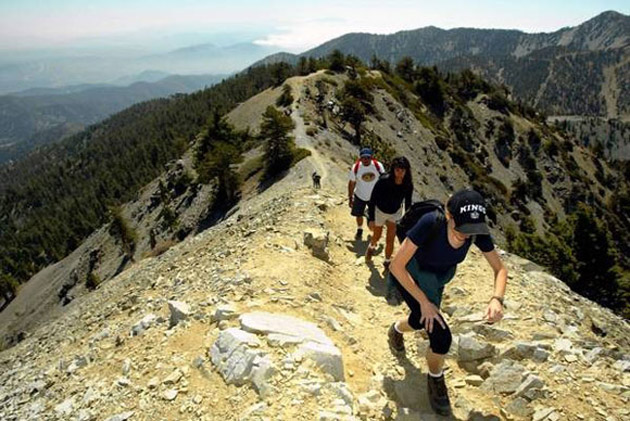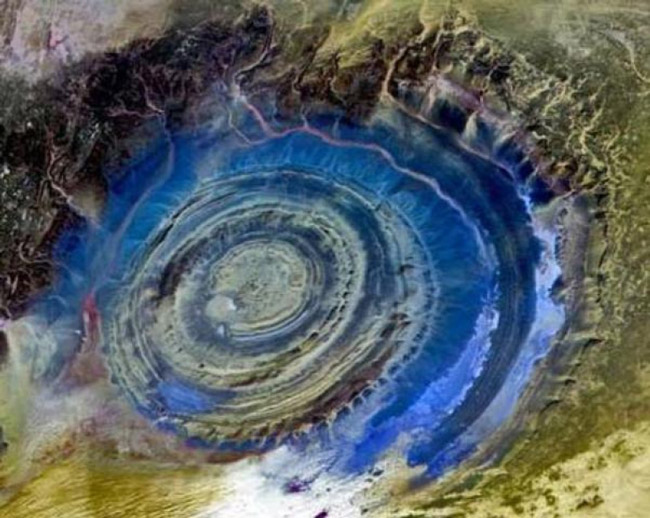The most bizarre phenomena on Earth
The accumulation of lava at a rapid rate beneath the volcano in Bolivia, concentric circles in the Sahara desert are some geological phenomena that scientists cannot explain.
Mysterious natural phenomena in the world
Hole "swallowing people" on sandy mountains
Baldy is the name of the highest sand mountain on the southern edge of Lake Michigan in the United States. Its height is up to 370m. People use the word "live dune" to describe Baldy because it moves from 100 to 200cm per year. Sand dunes begin to move when visitors pluck grass - which helps the sand layers join together. Wind is the culprit causing Baldy Mountain to move. However, its ability to swallow people is a matter of shocking scientists.

Visitors climb Baldy Mountain on the southern edge of Lake Michigan
In July 2013, Nathan Woessner - a 6-year-old boy - suffered on Baldy sand mountain due to an unexpected pit below. The depth of the pit is up to 3m. It took everyone three hours to pull Nathan out of the hole. A month later, the second hole appeared. This is a mysterious phenomenon because pits cannot form in sand. Every time a hole appears, the sand will immediately enter and the hole will disappear.
"It seems that we are witnessing a new geological phenomenon , " said Erin Argyilan, a geologist studying Baldy sand dunes.
Erin said that during the shifting process, the sand dunes filled up quite a lot of trees. Those trees rotten beneath the sand and release the gas. The pit appears because the gas escapes from below. People used to exploit Baldy to get sand for glass production. So it is very likely that exploitation is the cause of the pits.
Concentric circles in the Sahara desert

An image of "Sahara's eyes" captured by artificial satellites
"Sahara's Eye" is a circular area with a diameter of up to 50 km in the world's hottest desert. It consists of many concentric circles of blue. If you sit in a spaceship on earth orbit, you can see it. For a long time, scientists thought "Sahara's eyes" were the result of a meteorite collision with the earth. But a recent study shows that this hypothesis is not reasonable. If the meteorite falls to Earth, the pressure and temperature of the impact will leave many compounds such as coesite, a form of silicon dioxide.
Strange volcanoes in the Americas
Uturuncu , a volcano 6,000m high in southwestern Bolivia, last erupted from 300,000 years ago. Satellite images show that lava is forming at very high speeds under volcanoes over the past 20 years. According to calculations by some geologists, the volume of lava increases to 1m 3 per second. So the area around the volcano - up to 70km wide - is bulging at a rate of several centimeters per year, Newscarist reports.

Smoke, dust rising from the volcano Uturuncu
The first question is: How many years has the bulging process taken place? Scientists studied the area around the volcano, but they could not find an answer. What will Uturuncu look like in the future is also a mystery. Shan de Silva, a volcanic expert of Oregon University in the US, has been studying Uturuncu since 2006. Shan predicted it could become a super volcano. Other geologists did not find convincing evidence to support Shan's prediction. Even so, 300,000 years is the average time between volcanic eruptions in northwestern Bolivia. Therefore, it is likely that Uturuncu is about to create a big event.
Grand Canyon, USA

The Colorado River flows through the Grand Canyon.(Photo: Bloomsbeat.)
Grand Canyon is a steep canyon in the state of Arizona, USA. It is one of the most famous geological formations on earth and is also the leading research object of scientists. A group of scientists said that the Colorado River cut across and created the Grand Canyon. Meanwhile, the other group confirmed that the ravine had existed for a long time and the Colorado River was "unknowingly" flowing through. The controversy over the Grand Canyon revolves around the time it took to form. Some people believe that the Grand Canyon appeared about 6 million years ago while many others believe that number is 70 million years.
Unique pink color of Lake Hillier, Australia

Looking down from above, Hillier Lake looks like a piece of pink gum.(Photo: Amusing Planet)
Although Hillier is not the only pink lake in the world, it certainly contains the most mysteries. Hillier Lake was discovered in 1802 on a large island in the Recherche Islands, western Australia.
Unlike other pink lakes like Retba Lake and Salt Lake in San Francisco Bay, scientists have not yet determined the cause of Lake Hilier's water pink . Some people believe that the lake is pink due to the combination of shrimp species and microorganisms such as halobacteria or dunaliella salina. Many people speculate that the algae layer caused the lake to turn. Meanwhile, many people agree with the salt's ability to react in the lake that causes the lake to be pink. The water color of Hillier Lake is not a work of sunlight either, because people have taken a bucket of water from the lake and moved it to many places, but the water color remains the same. Although the scientific community has not yet determined the exact cause, but the charming pink of the lake has added to the beauty of the beautiful nature of Australia.
Outer coating of desert rocks

The shell of the desert rock is pink and black.(Photo: Listverse.)
A thin layer of pink and black substance existed outside the rocks in the desert. By scraping the coating, the ancient people created unique carvings. Although desert rocks appear all over the earth, the cause of their overlay is still a mystery.
The paint is composed mainly of clay. Meanwhile, iron and manganese - two substances that determine the color and mystery of stone - account for about one third. Experiments have shown that microorganisms can produce these compounds. However, another hypothesis shows that bacteria can also create paint outside desert rocks at very fast speeds. Based on the composition of the silica-rich paint, many researchers believe that dust in the air causes the stone shell to be pink and black. Meanwhile, according to the most recent assumption, this paint is made up of microorganisms in a completely strange biological form. The mystery of the outer shell of the desert rock will continue to be a topic for researchers to explore and consider.
- Explain the 'bursting' series of 'strange phenomena' that make everyone ache
- 5 utopian phenomena can happen under a physical perspective
- Virtual astronomical phenomena in April
- Discover a series of bizarre creatures in the deepest abyss of Earth
- 8 incredible bizarre animals exist in the world
- Top 15 strange natural phenomena (2)
- Strange natural phenomena only occur when it is cold
- Ten phenomena have no solution
- Marvel at the horned banana tree in Gia Lai
- Strange phenomena can only be seen in the universe
- 'Glimpse' strange monsters exist on Earth
- Find out the most strange cause of nature
 'Fine laughs' - Scary and painful torture in ancient times
'Fine laughs' - Scary and painful torture in ancient times The sequence of numbers 142857 of the Egyptian pyramids is known as the strangest number in the world - Why?
The sequence of numbers 142857 of the Egyptian pyramids is known as the strangest number in the world - Why? History of the iron
History of the iron What is alum?
What is alum? Discover the mystery behind the world's roundest natural lake
Discover the mystery behind the world's roundest natural lake  Mysterious wonders of the world
Mysterious wonders of the world  The strange life of the 'black blood' tribe living on the world's highest freshwater lake
The strange life of the 'black blood' tribe living on the world's highest freshwater lake  The Mystery and Engineering Feat of Albano Emissary: The 2,000-Year-Old Roman Tunnel
The Mystery and Engineering Feat of Albano Emissary: The 2,000-Year-Old Roman Tunnel  Hundreds of fish jumped out of the lake in China, what happened?
Hundreds of fish jumped out of the lake in China, what happened?  Mysterious blue rock gives scientists a headache
Mysterious blue rock gives scientists a headache 